[English] 日本語
 Yorodumi
Yorodumi- PDB-2jqn: Solution NMR structure of CC0527 from Caulobacter crescentus. Nor... -
+ Open data
Open data
- Basic information
Basic information
| Entry | Database: PDB / ID: 2jqn | ||||||
|---|---|---|---|---|---|---|---|
| Title | Solution NMR structure of CC0527 from Caulobacter crescentus. Northeast Structural Genomics Target CCR55 | ||||||
 Components Components | Hypothetical protein | ||||||
 Keywords Keywords | STRUCTURAL GENOMICS / solution NMR structure / PSI-2 / Protein Structure Initiative / Northeast Structural Genomics Consortium / NESG | ||||||
| Function / homology | Protein of unknown function DUF952 / Protein of unknown function DUF952 / Protein of unknown function (DUF952) / ADP-ribosylation fold / Alpha-Beta Barrel / Alpha Beta / DUF952 domain-containing protein Function and homology information Function and homology information | ||||||
| Biological species |  Caulobacter vibrioides (bacteria) Caulobacter vibrioides (bacteria) | ||||||
| Method | SOLUTION NMR / simulated annealing | ||||||
 Authors Authors | Aramini, J.M. / Rossi, P. / Moseley, H.N.B. / Wang, D. / Nwosu, C. / Cunningham, K. / Ma, L. / Xiao, R. / Liu, J. / Baran, M.C. ...Aramini, J.M. / Rossi, P. / Moseley, H.N.B. / Wang, D. / Nwosu, C. / Cunningham, K. / Ma, L. / Xiao, R. / Liu, J. / Baran, M.C. / Swapna, G.V.T. / Acton, T.B. / Rost, B. / Montelione, G.T. / Northeast Structural Genomics Consortium (NESG) | ||||||
 Citation Citation |  Journal: To be Published Journal: To be PublishedTitle: Solution NMR structure of CC0527 from Caulobacter crescentus Authors: Aramini, J.M. / Rossi, P. / Moseley, H.N.B. / Wang, D. / Nwosu, C. / Cunningham, K. / Ma, L. / Xiao, R. / Liu, J. / Baran, M.C. / Swapna, G.V.T. / Acton, T.B. / Rost, B. / Montelione, G.T. | ||||||
| History |
|
- Structure visualization
Structure visualization
| Structure viewer | Molecule:  Molmil Molmil Jmol/JSmol Jmol/JSmol |
|---|
- Downloads & links
Downloads & links
- Download
Download
| PDBx/mmCIF format |  2jqn.cif.gz 2jqn.cif.gz | 691.6 KB | Display |  PDBx/mmCIF format PDBx/mmCIF format |
|---|---|---|---|---|
| PDB format |  pdb2jqn.ent.gz pdb2jqn.ent.gz | 577.2 KB | Display |  PDB format PDB format |
| PDBx/mmJSON format |  2jqn.json.gz 2jqn.json.gz | Tree view |  PDBx/mmJSON format PDBx/mmJSON format | |
| Others |  Other downloads Other downloads |
-Validation report
| Summary document |  2jqn_validation.pdf.gz 2jqn_validation.pdf.gz | 503.3 KB | Display |  wwPDB validaton report wwPDB validaton report |
|---|---|---|---|---|
| Full document |  2jqn_full_validation.pdf.gz 2jqn_full_validation.pdf.gz | 616.9 KB | Display | |
| Data in XML |  2jqn_validation.xml.gz 2jqn_validation.xml.gz | 37.9 KB | Display | |
| Data in CIF |  2jqn_validation.cif.gz 2jqn_validation.cif.gz | 62.3 KB | Display | |
| Arichive directory |  https://data.pdbj.org/pub/pdb/validation_reports/jq/2jqn https://data.pdbj.org/pub/pdb/validation_reports/jq/2jqn ftp://data.pdbj.org/pub/pdb/validation_reports/jq/2jqn ftp://data.pdbj.org/pub/pdb/validation_reports/jq/2jqn | HTTPS FTP |
-Related structure data
| Related structure data | |
|---|---|
| Similar structure data | |
| Other databases |
- Links
Links
- Assembly
Assembly
| Deposited unit | 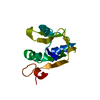
| |||||||||
|---|---|---|---|---|---|---|---|---|---|---|
| 1 |
| |||||||||
| NMR ensembles |
|
- Components
Components
| #1: Protein | Mass: 13529.084 Da / Num. of mol.: 1 Source method: isolated from a genetically manipulated source Source: (gene. exp.)  Caulobacter vibrioides (bacteria) / Gene: CC0527 / Production host: Caulobacter vibrioides (bacteria) / Gene: CC0527 / Production host:  |
|---|
-Experimental details
-Experiment
| Experiment | Method: SOLUTION NMR | ||||||||||||||||||||||||||||||||||||||||||||||||||||||||||||||||||||||||||||
|---|---|---|---|---|---|---|---|---|---|---|---|---|---|---|---|---|---|---|---|---|---|---|---|---|---|---|---|---|---|---|---|---|---|---|---|---|---|---|---|---|---|---|---|---|---|---|---|---|---|---|---|---|---|---|---|---|---|---|---|---|---|---|---|---|---|---|---|---|---|---|---|---|---|---|---|---|---|
| NMR experiment |
| ||||||||||||||||||||||||||||||||||||||||||||||||||||||||||||||||||||||||||||
| NMR details | Text: THE STRUCTURE WAS DETERMINED USING TRIPLE RESONANCE AND GFT NMR SPECTROSCOPY. AUTOMATED BACKBONE ASSIGNMENTS WERE MADE USING AUTOASSIGN, AND THE SIDE CHAIN ASSIGNMENTS WERE COMPLETED MANUALLY. ...Text: THE STRUCTURE WAS DETERMINED USING TRIPLE RESONANCE AND GFT NMR SPECTROSCOPY. AUTOMATED BACKBONE ASSIGNMENTS WERE MADE USING AUTOASSIGN, AND THE SIDE CHAIN ASSIGNMENTS WERE COMPLETED MANUALLY. AUTOMATIC NOESY ASSIGNMENTS AS WELL AS DISTANCE, DIHEDRAL ANGLE (HYPER) AND HYDROGEN BOND CONSTRAINTS WERE DETERMINED USING AUTOSTRUCTURE. COMPLETENESS OF NMR ASSIGNMENTS (EXCLUDING C-TERMINAL HHHHHH): BACKBONE, 97.6%, SIDE CHAIN, 96.5%, AROMATICS, 89.1%, STEREOSPECIFIC METHYL, 91.3%. FINAL STRUCTURE QUALITY FACTORS (FOR RESIDUES 1 TO 116, PSVS 1.3), WHERE ORDERED RESIDUES [S(PHI) + S(PSI) > 1.8] COMPRISE: 3-22,26-31,34-35,40-49,56-62,69-73,80-96,109-112: (A) RMSD (ORDERED RESIDUES): BB, 0.9, HEAVY ATOM, 1.3. (B) RAMACHANDRAN STATISTICS FOR ORDERED RESIDUES: MOST FAVORED, 91.3%, ADDITIONALLY ALLOWED, 8.7%, GENEROUSLY ALLOWED, 0.0%, DISALLOWED, 0.0%. (C) PROCHECK SCORES FOR ORDERED RESIDUES (RAW/Z-): PHI-PSI, -0.25/-0.67, ALL, -0.15/-0.89. (D) MOLPROBITY CLASH SCORE (RAW/Z-): 19.99/-1.90. (E) RPF SCORES FOR GOODNESS OF FIT TO NOESY DATA (RESIDUES 1-116): RECALL, 0.985, PRECISION, 0.900, F-MEASURE, 0.941, DP-SCORE, 0.755. THE C-TERMINAL HIS TAG RESIDUES OF THE PROTEIN (HHHHHH) WERE INCLUDED IN ALL STRUCTURE CALCULATIONS BUT HAVE BEEN OMITTED FROM THIS DEPOSITION. COORDINATES FOR THE FOLLOWING RESIDUES ARE NOT WELL DETERMINED (S(PHI) + S(PSI) < 1.8): 1-2,23-25,32-33,36-39,50-55,63-68,74-79,97-108,113-116. |
- Sample preparation
Sample preparation
| Details |
| ||||||||||||||||||||||||||||||||||||||||||||||||||||||||||||||||||||||||||||
|---|---|---|---|---|---|---|---|---|---|---|---|---|---|---|---|---|---|---|---|---|---|---|---|---|---|---|---|---|---|---|---|---|---|---|---|---|---|---|---|---|---|---|---|---|---|---|---|---|---|---|---|---|---|---|---|---|---|---|---|---|---|---|---|---|---|---|---|---|---|---|---|---|---|---|---|---|---|
| Sample |
| ||||||||||||||||||||||||||||||||||||||||||||||||||||||||||||||||||||||||||||
| Sample conditions | Ionic strength: 100 / pH: 6.5 / Pressure: ambient / Temperature: 293 K |
-NMR measurement
| NMR spectrometer |
|
|---|
- Processing
Processing
| NMR software |
| ||||||||||||||||||||||||||||||||||||||||||||||||||||||||
|---|---|---|---|---|---|---|---|---|---|---|---|---|---|---|---|---|---|---|---|---|---|---|---|---|---|---|---|---|---|---|---|---|---|---|---|---|---|---|---|---|---|---|---|---|---|---|---|---|---|---|---|---|---|---|---|---|---|
| Refinement | Method: simulated annealing / Software ordinal: 1 Details: THE STRUCTURES ARE BASED ON A TOTAL OF 1164 CONFORMATIONALLY-RESTRICTING NOE-DERIVED DISTANCE CONSTRAINTS, 108 DIHEDRAL ANGLE CONSTRAINTS, AND 66 HYDROGEN BOND CONSTRAINTS (11.7 CONSTRAINTS ...Details: THE STRUCTURES ARE BASED ON A TOTAL OF 1164 CONFORMATIONALLY-RESTRICTING NOE-DERIVED DISTANCE CONSTRAINTS, 108 DIHEDRAL ANGLE CONSTRAINTS, AND 66 HYDROGEN BOND CONSTRAINTS (11.7 CONSTRAINTS PER RESIDUE, 3.6 LONG RANGE CONSTRAINTS PER RESIDUE, COMPUTED FOR RESIDUES 1 TO 116 BY PSVS 1.3). STRUCTURE DETERMINATION WAS PERFORMED ITERATIVELY USING AUTOSTRUCTURE (XPLOR-NIH). AFTER A FINAL XPLOR CALCULATION USING THE CONSTRAINTS DERIVED FROM AUTOSTRUCTURE, THE 20 LOWEST ENERGY STRUCTURES OUT OF 100 WERE FURTHER REFINED BY RESTRAINED MOLECULAR DYANMICS/ENERGY MINIMIZATION IN EXPLICIT WATER (CNS). | ||||||||||||||||||||||||||||||||||||||||||||||||||||||||
| NMR constraints | NOE constraints total: 1164 / NOE intraresidue total count: 221 / NOE long range total count: 375 / NOE medium range total count: 244 / NOE sequential total count: 324 | ||||||||||||||||||||||||||||||||||||||||||||||||||||||||
| NMR representative | Selection criteria: lowest energy | ||||||||||||||||||||||||||||||||||||||||||||||||||||||||
| NMR ensemble | Conformer selection criteria: structures with the lowest energy Conformers calculated total number: 100 / Conformers submitted total number: 20 / Maximum torsion angle constraint violation: 2.1 ° / Maximum upper distance constraint violation: 0.17 Å | ||||||||||||||||||||||||||||||||||||||||||||||||||||||||
| NMR ensemble rms | Distance rms dev: 0.01 Å |
 Movie
Movie Controller
Controller


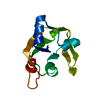
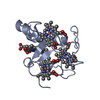
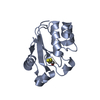
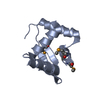


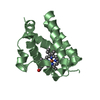
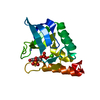
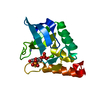
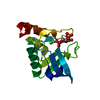
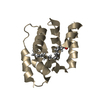
 PDBj
PDBj HSQC
HSQC